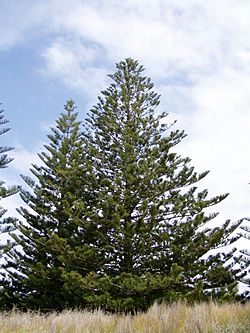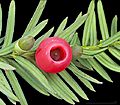Conifer facts for kids
Quick facts for kids Conifera |
|
|---|---|
 |
|
| Trees of a Pinophyta species: Araucaria heterophylla (Araucariaceae) |
|
| Scientific classification | |
| Kingdom: | |
| Division: |
Pinophyta
|
| Class: |
Pinopsida
|
| Orders & Families | |
|
Cordaitales † |
|
Conifers are special plants that grow cones and have seeds. Most conifers are tall trees, but some are smaller shrubs. They are part of a plant group called Pinophyta or Coniferophyta.
Conifers are also known as Gymnosperms. This means their seeds are "naked" and not inside a fruit. They have special tubes inside them called vascular tissue to carry water and nutrients. All living conifers are woody plants, and most of them are trees.
You can find many types of conifers around the world. Some common examples include cedars, cypresses, firs, junipers, kauris, larches, pines, redwoods, spruces, and yews.
Where Do Conifers Grow?
Conifers grow in almost every part of the world. They are often the most common plants in their habitats. For example, huge forests of conifers cover the cold taiga regions.
Conifers are very important for people and the economy. Their wood is mostly used to make timber for building and to make paper. Conifer wood is often called "softwood." However, some conifer wood, like that from yew trees, can be quite hard. There are about 700 different kinds of conifers alive today.
How Conifers Evolved
The first conifers appeared a very long time ago, about 300 million years ago. This was during a period called the late Carboniferous time. At this time, plants like Pinophytes, Cycads, and Ginkgos all started to develop.
These new plants were able to live without needing as much water as older plants. They developed special adaptations to help them survive. One important adaptation was pollen, which allowed them to reproduce without needing water. Another was the seed, which helped their embryos travel and grow in new places.
Conifers seemed to do well after a big event called the Permian–Triassic extinction event. They became the main type of land plant during the Mesozoic era, which was the time of the dinosaurs. Later, flowering plants appeared in the Cretaceous period and eventually became more common. Flowering plants became the most dominant plants in the Cainozoic era, which is our current era.
Conifers were a major food source for plant-eating dinosaurs. Their resin (a sticky sap) and natural poisons likely helped protect them from being eaten too much. All the ways modern conifers reproduce had already developed by the end of the Mesozoic era.
Related Pages
Images for kids
-
Pinaceae: needle-like leaves and vegetative buds of Coast Douglas fir (Pseudotsuga menziesii var. menziesii)
-
Araucariaceae: Awl-like leaves of Cook Pine (Araucaria columnaris)
-
In Abies grandis (grand fir), and many other species with spirally arranged leaves, leaf bases are twisted to flatten their arrangement and maximize light capture.
-
Cupressaceae: scale leaves of Lawson's Cypress (Chamaecyparis lawsoniana); scale in mm
-
A Monterey Pine forest in Sydney, Australia
-
Globosa, a cultivar of Pinus sylvestris, a northern European species, in the North American Red Butte Garden
-
Pinaceae: unopened female cones of subalpine fir (Abies lasiocarpa)
-
Taxaceae: the fleshy aril that surrounds each seed in the European Yew (Taxus baccata) is a highly modified seed cone scale
See also
 In Spanish: Coníferas para niños
In Spanish: Coníferas para niños












